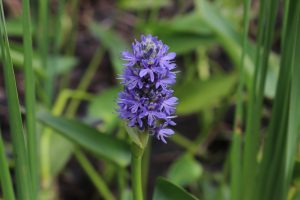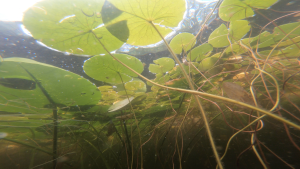by Ty Fischer, Riparian Health Restoration Intern
Aquatic plants in our lakes and rivers are often referred to as ‘weeds’, and the use of this term shows how they are generally perceived by waterfront property owners – as a nuisance. This is because the vegetation can get tangled in boat motors, tickle the toes of swimming passerby, complicate fishing endeavours, and is just generally seen as an unattractive part of the waterway.
The irony is that every single amenity offered by our lakes and rivers – that is, all the main reasons why we are so drawn to these areas in the first place – are maintained by these so-called ‘weeds’. Aquatic plant communities serve many of the same ecological functions that terrestrial plant communities do and are just as important for the health and proper function of the ecosystem in which they are found (NHDES, 2019). That is why, whether you are a boater, an angler, a swimmer, or a birdwatcher, working to conserve aquatic vegetation will simultaneously help conserve the health of these critically important ecosystems that we enjoy and that our native wildlife rely on.

Pickerelweed (Pontederia cordata), an emergent aquatic plant.
Aquatic plants can be either emergent (growing up past the surface of the water), floating (remaining suspended on the surface), or submerged (entirely aquatic). Between all this structural diversity emerges countless niches that are occupied by a diverse variety of wildlife. For example, emergent vegetation provides food, habitat, and spawning grounds for waterfowl and grazing opportunities for mammals such as moose (NHDES, 2019). The entire order Odonata, which includes damselflies and dragonflies, rely on emergent vegetation to lay their eggs and to anchor themselves when transitioning from their nymph stage into their adult stage (Perron, Pick, 2020). Floating aquatic vegetation is equally important as it provides needed shade for shallow-water fish and other aquatic wildlife on hot summer days. Floating vegetation is also where many insect species feed and deposit their eggs. Finally, submerged vegetation serves as an underground forest that provides food, habitat, and spawning grounds for fish, amphibians, reptiles, and even microscopic zooplankton that are an essential part of the food chain (NHDES, 2019). Overall, aquatic plant communities help support a wide variety of native plants and animals by providing them with habitat and food.
Submerged aquatic vegetation provides many other benefits to the ecosystem outside of habitat and food, though. Submerged aquatic vegetation species are primary producers, contributing to the flow of energy at the base of the food web via epiphytic plankton and microbial biofilms (Wetzel, 2001). The plants also oxygenize the water through the process of photosynthesis, enriching the diversity and function of aquatic soil microbial communities (Kemp, Murray, 1986), and increasing invertebrate abundance (Beckett et al., 1992). Furthermore, high submerged aquatic vegetation abundance can attenuate the flow of water which reduces sediment resuspension and turbidity in the water column and thereby improves water clarity (Zhu et al., 2015). This allows for greater rates of photosynthesis overall.
Submerged aquatic vegetation can also reduce populations of harmful phytoplankton such as cyanobacteria in three separate ways; by drawing down and sequestering excess nutrients (van Donk, van de Bund, 2002), by releasing allelopathic substances (ones that inhibit the growth of another organism) (Netzbrytska et al., 2022), and by promoting the growth of the larger zooplankton that graze on them. Finally, healthy communities of native aquatic plants can help resist invasion by foreign species such as bladderwort and Eurasian watermilfoil, which are becoming major threats to freshwater biodiversity (Petruzzella et al., 2018). In these ways and more, submerged aquatic vegetation helps to improve and maintain water quality and clarity and help hold the natural balance in our freshwater ecosystems.

It is important to note that freshwater areas abundant in aquatic vegetation also serve as important tools for climate change mitigation. They can mitigate the prevalence of climate change by sequestering and storing atmospheric carbon in the form of living plant tissues and decomposed vegetation (Kayranli et al., 2010). Wetlands – densely vegetated areas that have high groundwater as a result of permanent or temporary flooding – are of particular importance as they can softening the blow of flooding events (Environment Canada, 2016). Wetlands also store an estimated 20-30% of the global carbon pool and playing a significant role in the atmospheric carbon cycle (Lal, 2008). Overall, this potential for climate change mitigation makes conserving aquatic vegetation wherever possible a valuable investment into the future health of not only the local ecosystem, but of the whole natural world.
All of these benefits provided by native aquatic vegetation reinforce the idea that applies to nearly every aspect of responsible waterfront property management; that leaving things in their natural state as much as possible is often the best approach. This is especially important due to the fact that aquatic vegetation levels have been declining globally in recent years due to warming temperatures, excess algae growth, and herbicide leaching (Zhang et al., 2020). As with riparian buffers, conserving aquatic vegetation will provide ongoing benefits for our native wildlife, for water quality and water clarity, for climate change mitigation, and our continued enjoyment of our waterways.
References
Beckett, D. C., Aartila, A.C., Miller, A.C. (1992) Invertebrate abundance of Potomogeton nodsus: effects on plant surface area and condition. Canadian Journal of Zoology, 70:300-306
Environment Canada. (2016, January 14). Water Sources: Wetlands. Government of Canada. https://www.canada.ca/en/environment-climate-change/services/water-overview/sources/wetlands.html
Kayranli, B., Scholz, M., Mustafa, A., & Hedmark, A. (2010). Carbon storage and fluxes within freshwater wetlands: A critical review. Wetlands, 30(1), 111-124. https://doi.org/10.1007/s13157-009-0003-4
Kemp, W.M., Murray, L. (1986). Oxygen release from roots of the submersed macrophyte Potomogeton Perfoliatus L.: regulating factors and ecological implications. Aquatic Botany. 26:271-283
Lal, R. (2008). Carbon sequestration. Philosophical Transactions of the Royal Society B: Biological Sciences, 363(1492), 815-830. https://doi.org/10.1098/rstb.2007.2185
Nezbrytska, I., Usenko, O., Konvets, I., Leontieva, T., Abramiuk, I., Goncarova, M., Bilous, Ol. (2022) Potential use of aquatic vascular plants to control cyanobacterial blooms: A review. Water 14:1727.
NHDES (2019). Aquatic Plants and Their Role in Lake Ecology [Fact Sheet]. New Hampshire Department of Environmental Services. https://www.des.nh.gov/sites/g/files/ehbemt341/files/documents/2020-01/bb-44.pdf
Petruzzella, A., Manschot, J., van Leeuwen, C. H., Grutters, B. M., & Bakker, E. S. (2018). Mechanisms of invasion resistance of Aquatic Plant Communities. Frontiers in Plant Science, 9. https://doi.org/10.3389/fpls.2018.00134
Perron, M. A., & Pick, F. R. (2019). Stormwater Ponds as habitat for Odonata in urban areas: The importance of obligate wetland plant species. Biodiversity and Conservation, 29(3), 913–931. https://doi.org/10.1007/s10531-019-01917-2
van Donk, E., & van de Bund, W. J. (2002). Impact of submerged macrophytes including charophytes on phyto- and zooplankton communities: Allelopathy versus other mechanisms. Aquatic Botany, 72(3–4), 261–274. https://doi.org/10.1016/s0304-3770(01)00205-4
Wetzel, R.G. (2001). Limnology: Lake and River Ecosystems, 3rd Ed. Academic Press, New York, NY, USA, 1024 pp.
Zhang, P., Wang, T., Zhang, H., Wang, H., Hilt, S., Shi, P., Cheng, H., Feng, M., Pan, M., Guo, Y., Wang, K., Xu, X., Chen, J., Zhao, K., He, Y., Zhang, M., & Xu, J. (2022). Heat waves rather than continuous warming exacerbate impacts of nutrient loading and herbicides on aquatic ecosystems. Environment International, 168, 107478. https://doi.org/10.1016/j.envint.2022.107478
Zhu, M, Zhu, G., Nurminen, L., Wu, T., Deng, J., Zhang, Y, Qin, B., Ventela, A-M. (2015). The influence of macrophytes on sediment resuspension and the effect of associated nutrients in a shallow and large lake (Lake Taihu, China). Plos One 10, e0127915.
This blog post is part of a Climate Change toolkit, generously funded by The Catherine and Maxwell Meighen Foundation. Access the full toolkit here.

Hello,
I am the President of the Gloucester Pool Cottagers’ Association. Every year we publish a magazine which include environmental issue.
Would you give us permission to publish this article?
Thanks,
Cheryl